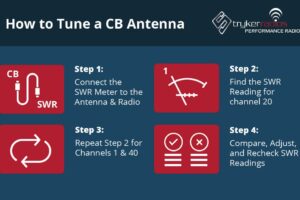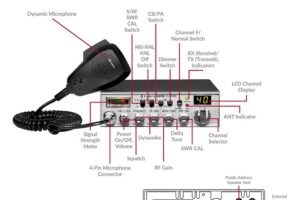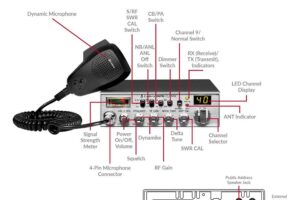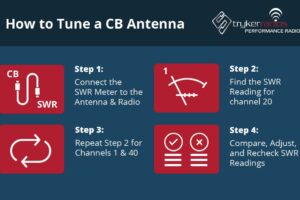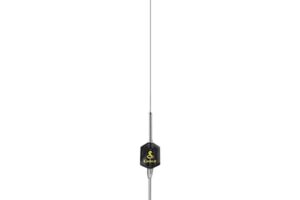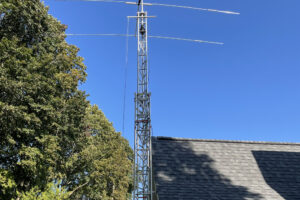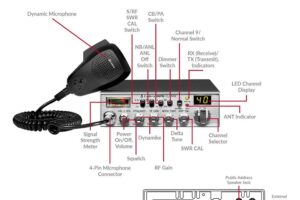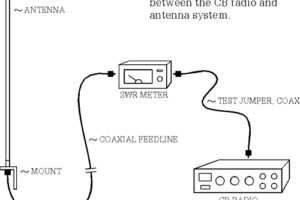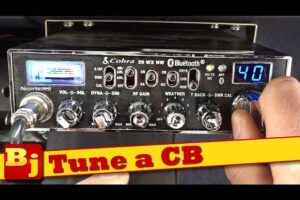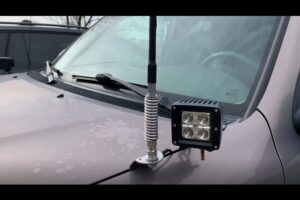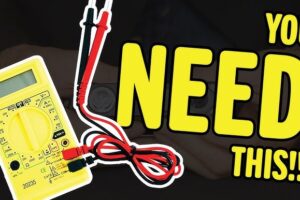Tuning a CB Radio Antenna: Master Clear Signals
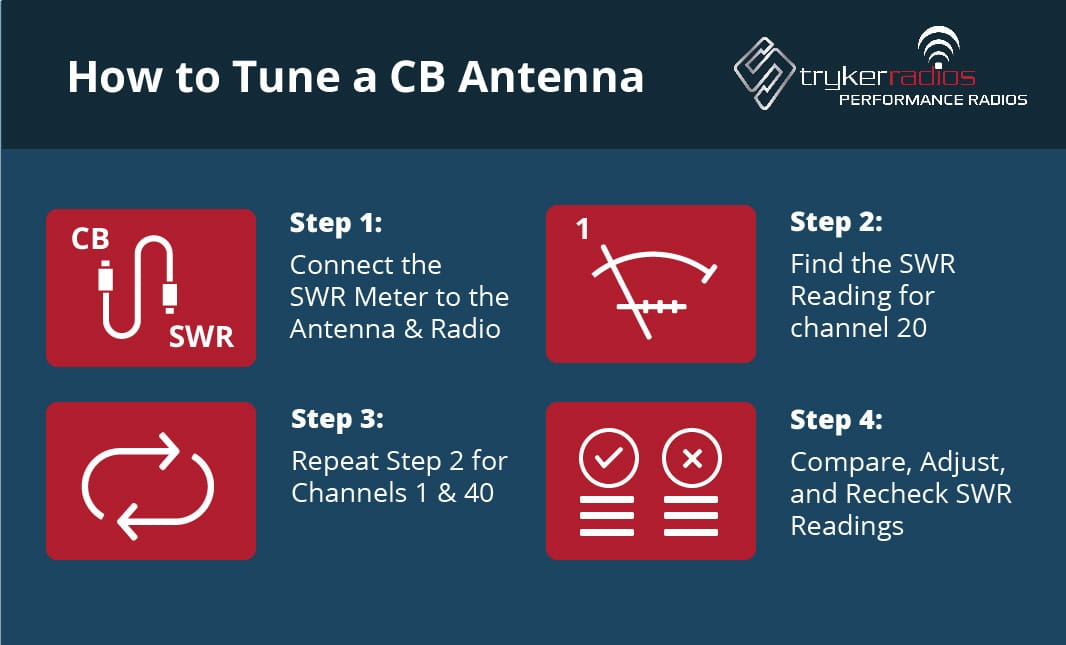
CB radios require a properly tuned antenna for optimal performance. A well-tuned antenna enhances communication range and clarity.
Tuning a CB radio antenna isn’t just for enthusiasts; it’s essential for anyone using these devices. Whether you’re a truck driver relying on clear signals or a hobbyist connecting with others, understanding how to tune your antenna can make all the difference.
An untuned antenna can lead to poor signal transmission and reception, affecting your communication experience. This guide will help you grasp the basics of antenna tuning, ensuring you get the best performance from your CB radio. With a few simple adjustments and tools, you can improve your CB radio’s effectiveness significantly. Dive in and learn how to maximize your CB radio’s potential by tuning its antenna correctly.
Introduction To Cb Radio Antennas
CB radios have been a staple in communication for hobbyists and professionals alike. But to get the best performance, understanding the role of the CB radio antenna is crucial. A well-tuned antenna can drastically improve your signal quality.
CB radios operate on specific frequencies to send and receive signals. Without a properly tuned antenna, these signals can be weak or distorted. Think of the antenna as the bridge between your radio and the world outside.
Each CB radio comes with unique specifications. Knowing these helps you choose the right antenna. A trucker once told me he couldn’t reach his buddies until he adjusted his antenna. That small tweak made all the difference.
Tuning your antenna isn’t just a technical requirement; it’s a game-changer. Imagine driving through dense forests or remote areas. A tuned antenna ensures your messages are clear and uninterrupted.
Have you ever tried to make a call with poor reception? Frustrating, right? That’s similar to using a CB radio without tuning the antenna. Proper tuning enhances clarity and range, making every conversation crisp and reliable.
Why settle for less when you can have optimal performance? What steps will you take to ensure your CB radio works at its best? Consider these insights and make the most of your CB radio experience.
Credit: www.rightchannelradios.com
Components Of A Cb Radio System
Understanding the components of a CB radio system can feel like navigating a new world, but it’s worth the effort. Each part plays a crucial role in how effectively your radio communicates. Knowing these components can help you tune your CB radio antenna more effectively, ensuring clear communication whether you’re trucking across the country or just chatting with friends locally.
Transmitter And Receiver Basics
The heart of your CB radio system is the transmitter and receiver. The transmitter sends out radio waves, while the receiver picks up signals from other radios. Picture this: you’re on a long road trip, and your transmitter allows you to communicate with fellow drivers, sharing road conditions or just a friendly chat. A well-functioning receiver ensures you hear them clearly, making your journey safer and more enjoyable.
Have you ever wondered why sometimes your radio picks up static instead of clear voices? It might be due to interference or a poorly tuned receiver. Ensuring both the transmitter and receiver are in good condition can improve your communication quality significantly.
Role Of The Antenna
The antenna is the unsung hero of your CB radio system. It acts as the bridge between your radio and the world, sending and receiving signals. Imagine trying to talk to someone across a noisy room; a well-tuned antenna cuts through the noise, ensuring your message gets across clearly.
Choosing the right antenna can make a huge difference. A longer antenna generally provides better range, but it also needs proper tuning. Have you ever thought about how a simple adjustment in your antenna’s length can enhance your radio’s performance? It’s fascinating how such a small tweak can have a big impact.
Consider this: when was the last time you checked your antenna’s condition? A small crack or loose connection might be hindering your communication. Regular maintenance and tuning ensure your antenna performs at its best, keeping you connected when it matters most.
Types Of Cb Radio Antennas
Choosing the right CB radio antenna can feel like a daunting task. Yet, understanding the different types can make it much easier. Each type has unique features that can impact your communication experience. Let’s dive into two popular options: fiberglass antennas and magnetic mount antennas.
Fiberglass Antennas
Fiberglass antennas are a favorite among truck drivers and off-road enthusiasts. They are known for their durability and performance in harsh environments. The sturdy design can withstand the bumps and jolts of rugged terrains.
They offer a great balance between size and efficiency. If you’re looking for an antenna that can handle the elements, fiberglass might be your best bet. Their flexibility allows them to bend rather than break, providing reliability even when the going gets tough.
Have you ever found yourself in a remote area with no signal? A well-tuned fiberglass antenna can make all the difference. Their ability to reach distant signals is impressive. It’s like having a lifeline when you’re out exploring the wilderness.
Magnetic Mount Antennas
Magnetic mount antennas are incredibly convenient. They are perfect for those who prefer a temporary setup. You can easily attach and detach them from your vehicle without any tools.
They offer great portability and flexibility. Imagine you’re on a road trip and need to swap vehicles. No problem—just move the antenna with ease. This convenience is a game-changer for many CB radio users.
Do you worry about damaging your vehicle’s paint? Magnetic mounts are designed to be gentle. They offer a secure fit without leaving scratches or marks. It’s all about keeping things simple and efficient.
Whether you choose fiberglass or magnetic mount antennas, think about your needs and environment. Consider how often you’ll be using your CB radio and where. Your choice will directly impact your communication effectiveness. So, what kind of adventures are you preparing for?
Tools For Tuning Cb Antennas
Tuning a CB radio antenna can greatly improve communication quality. Proper tools are essential for this task. They ensure your antenna operates at its best. This section explores key tools needed for tuning CB antennas.
Swm Meter Usage
An SWR meter is crucial for tuning CB antennas. It measures the standing wave ratio (SWR). This ratio indicates how well your antenna is transmitting. Connect the SWR meter between the radio and antenna. It gives a reading on how much signal is reflected back. Lower SWR means better signal transmission. Adjust the antenna length based on SWR readings. Aim for a reading close to 1:1. This ensures optimal performance.
Essential Tuning Equipment
Several tools are essential for tuning CB antennas. A coaxial cable is needed for connecting components. It ensures stable signal transmission. Antenna analyzers help in precise tuning. They provide detailed information about antenna performance. Use a wrench for adjusting antenna length. It allows you to fine-tune the setup. A multimeter is useful for checking electrical connections. It verifies that your setup is correctly wired. These tools are fundamental for successful tuning.
Steps To Tune A Cb Antenna
Adjusting a CB radio antenna involves simple steps. First, check the SWR meter readings to ensure optimal performance. Then, make necessary adjustments to the antenna length for improved signal clarity.
Tuning a CB radio antenna might seem daunting, but with the right steps, it can be straightforward and rewarding. Ensuring your CB antenna is correctly tuned is crucial for optimal performance. It not only enhances signal clarity but also extends the range of your communication. Whether you’re a seasoned CB radio enthusiast or a newbie, understanding the steps to tune your CB antenna can make a world of difference in your radio experience. ###Initial Setup Procedures
Before diving into the tuning process, you need to prepare your setup. First, ensure that your CB radio and antenna are securely mounted. A loose connection can lead to inaccurate tuning results. Next, connect your SWR meter between the radio and the antenna. This device will help you measure the Standing Wave Ratio (SWR) to determine how well your antenna is tuned. Make sure your vehicle is parked in an open area, away from large buildings or metal objects. These can interfere with the signal and skew your readings. ###Adjusting The Antenna Length
Once your setup is ready, you can begin adjusting the antenna length. Check the SWR reading on your meter. Ideally, it should be as close to 1:1 as possible. If the reading is high, you might need to shorten or lengthen the antenna. Start by loosening the set screw on the antenna’s base and make small adjustments. After each adjustment, recheck the SWR reading. It’s a trial-and-error process, but patience here pays off. Have you ever adjusted your car’s mirrors repeatedly until they were just right? Tuning your antenna requires the same persistence. Once you achieve the desired SWR reading, tighten the set screw to secure the antenna in place. Now, your CB radio should be performing at its best, ready to deliver clear and reliable communication. Are you ready to experience the difference a well-tuned antenna makes?Testing Signal Clarity
Tuning a CB radio antenna enhances signal clarity. Adjusting the antenna’s length improves the transmission and reception quality. Proper tuning ensures clear communication over long distances, reducing static and interference.
Testing signal clarity is a crucial step in tuning your CB radio antenna. Without clear signals, communication becomes a guessing game. Whether you’re a trucker, a hobbyist, or simply someone relying on CB radios for essential communications, understanding how to assess and improve signal clarity is key.Conducting Swr Tests
To ensure your antenna is transmitting effectively, conduct SWR (Standing Wave Ratio) tests. SWR tests help you measure how efficiently your antenna is tuned. Start by connecting an SWR meter between your radio and the antenna. You’ll want to test the SWR on all 40 channels. This might sound tedious, but it’s necessary. An ideal SWR reading is 1:1, though readings up to 1.5:1 are acceptable. If your readings are higher, it indicates a problem with your setup.Interpreting Test Results
Understanding your SWR readings is essential. High readings suggest that not all the signal is being transmitted, which could damage your equipment. If the reading is high across all channels, your antenna might be too long or too short. Adjust the length of your antenna based on these readings. If the SWR is higher on lower channels, shorten the antenna. If it’s higher on the upper channels, lengthen it. Have you ever noticed how a slight adjustment can drastically change your reading? It’s like tuning a guitar – small tweaks make a big difference. Remember, patience and precision are your best friends here. Testing signal clarity can initially seem complex. But with consistent practice, you’ll quickly become adept at reading and interpreting SWR results. How do your current readings compare? Maybe it’s time for a tune-up.Troubleshooting Common Issues
Facing issues with tuning a CB radio antenna can be frustrating. Common problems often involve incorrect antenna length or poor grounding. Adjusting these can significantly improve signal clarity and range.
Tuning a CB radio antenna can sometimes feel like you’re trying to solve a mystery. Despite your best efforts, common issues can arise that impact the performance of your setup. Troubleshooting these problems can save you time and frustration, ensuring your CB radio operates at its best. Let’s dive into some frequent issues and explore solutions that can make your radio communication clearer and more reliable.Identifying Signal Interference
Signal interference can be a real headache. It often stems from nearby electronic devices or power lines. Have you noticed static or distorted voices on your CB radio? Check if there are any appliances or electronic gadgets near your setup. This interference can be minimized by relocating your CB radio to a different area. Another option is to invest in a noise filter. These are designed to block unwanted signals, helping you focus on what you need to hear.Fixing Poor Signal Reception
Poor signal reception is another common issue. You might find that your CB radio struggles to pick up signals from other stations. This can be frustrating, especially when clear communication is critical. Ensure your antenna is properly connected and not loose. Sometimes, a simple adjustment can make a world of difference. Consider the height of your antenna. Is it high enough to capture signals effectively? Raising it can improve reception, allowing you to communicate with stations further away. Lastly, check the surrounding environment. Tall buildings or dense trees can block signals. Finding a clearer path for your antenna can enhance performance significantly. Troubleshooting is all about knowing what to look for and taking actionable steps. Are you ready to tackle these challenges and improve your CB radio experience?Maintenance Tips For Cb Antennas
Maintaining your CB radio antenna is essential for optimal performance. Proper care ensures clear communication and extends the life of your equipment. This section provides valuable tips for keeping your CB antenna in top condition.
Regular Inspections
Check your CB antenna for damage every month. Look for cracks, rust, or loose connections. A visual inspection helps catch problems early. Replace damaged parts to avoid signal loss. Use a multimeter to test connections if needed. This ensures they work correctly.
Protecting Against Weather Damage
Weather can harm your CB antenna. Rain, snow, and wind are common threats. Use a weatherproof cover to protect your antenna. This reduces exposure to harsh elements. Ensure all connections are tight and sealed. A loose connection can allow moisture inside.
Consider using rust-resistant materials for outdoor antennas. Stainless steel and fiberglass are good choices. They resist corrosion better than other materials. Regular maintenance helps prevent weather damage over time.
Advanced Tuning Techniques
Advanced tuning techniques can improve your CB radio’s performance. These methods help you achieve clearer communication and a stronger signal. Understanding the science behind these techniques is key to maximizing your radio’s capabilities.
Understanding Ground Plane Effects
The ground plane affects your antenna’s performance. It acts as a mirror, reflecting signals for better transmission. A good ground plane can enhance signal strength. Ensure your vehicle’s body provides a solid ground. Metal surfaces work well for this purpose.
Check for rust or paint that might interfere. Clean these areas for a better connection. A proper ground plane improves signal clarity. It reduces interference and boosts communication range.
Maximizing Signal Range
To maximize your signal range, tune your antenna carefully. Start by adjusting the antenna length. Use a SWR meter to find the optimal position. A lower SWR reading means better performance.
Test the antenna in different environments. Urban areas might cause interference. Open spaces usually provide a clearer signal. Adjust your antenna accordingly for the best results. Regularly check your setup to maintain peak performance.
Remember, even small adjustments can make a big difference. Keep experimenting until you find the best settings.
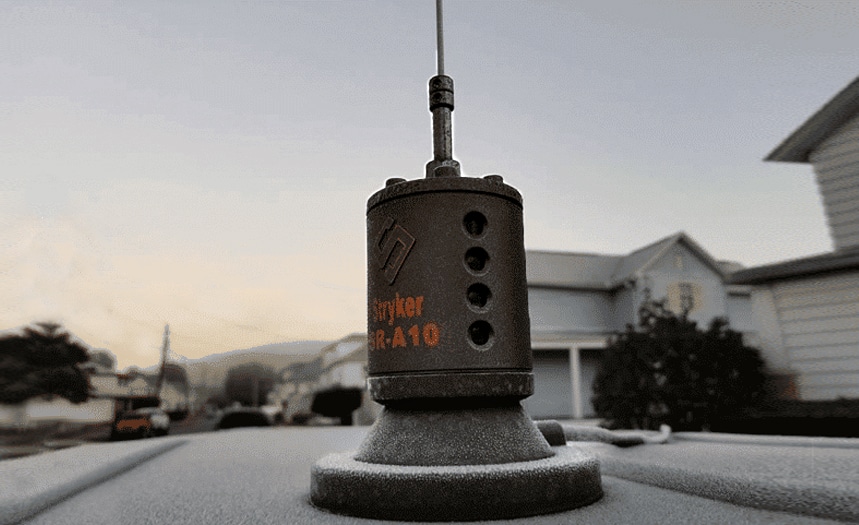
Credit: strykerradios.com
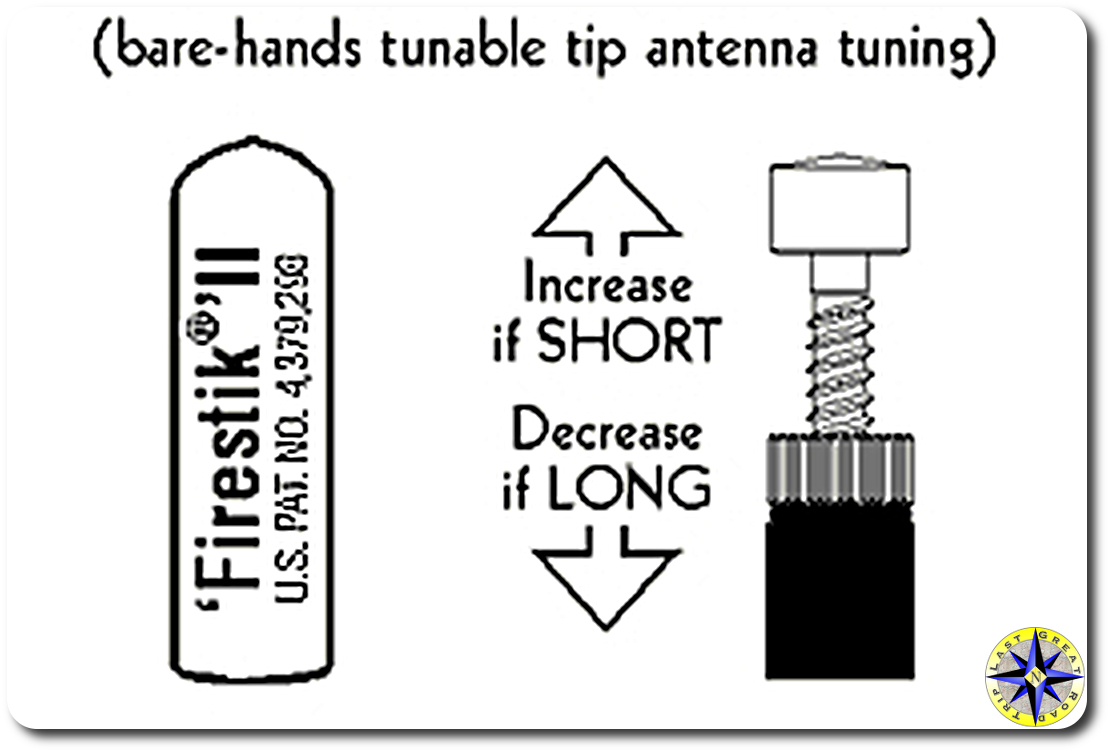
Credit: www.lastgreatroadtrip.com
Frequently Asked Questions
How Do I Tune My Cb Antenna?
To tune your CB antenna, adjust the antenna length for optimal SWR. Check using an SWR meter. Shorten or lengthen the antenna until the SWR reading is around 1:1. 5 or lower. Ensure all connections are secure for best performance.
How Can I Boost My Cb Antenna Signal?
Ensure the antenna is properly grounded. Use high-quality coaxial cable. Adjust the antenna’s SWR for optimal performance. Install the antenna in an elevated location, away from obstructions. Regularly check and maintain connections for any damage.
What Happens If You Don’t Tune A Cb Antenna?
Not tuning a CB antenna causes poor signal quality and reduced communication range. It leads to increased SWR, risking damage to your radio equipment. Proper tuning ensures optimal performance and prevents transmission issues. Tuning is crucial for efficient and clear communication.
What Channel Do You Calibrate Cb Radio On?
Calibrate your CB radio on channel 20 for optimal performance. It ensures balanced transmission and reception across all channels. Proper calibration enhances signal clarity and extends the radio’s range, making communication more effective. Always perform calibration in an open area away from obstructions for best results.
Conclusion
Tuning a CB radio antenna boosts your communication quality. Simple adjustments lead to clearer signals. Regular checks keep your setup effective. Experimenting with different positions helps find the best performance. Don’t rush; patience is key. Always follow safety guidelines during adjustments.
Reliable communication depends on a well-tuned antenna. Enjoy improved connections with friends and fellow enthusiasts. Explore new channels with ease. Feel confident in your setup. Proper tuning enhances your radio experience. Keep it fun and rewarding. Remember, practice makes perfect.
Happy tuning!

